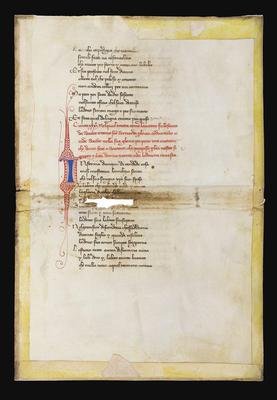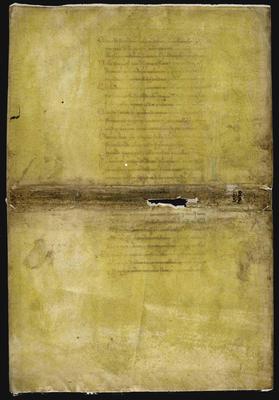Dante Alighieri
Commedia. Paradiso, XXX 139 - XXXI 45.
Fragment on vellum. Florence, mid-fourteenth century.317x240 mm ca. A single leaf, folded in half, used as a binding cover for a book in quarto format. Text block: 195x93 mm, one column, 30-31 lines. Probably ruled with dry point. Text written in dark brown ink in a Florentine chancery hand. Vernacular rubric prefacing Cantoxxxiwritten in red. On the recto three-line initial in blue with extensive flourishes in red penwork. The first capital letter of each terzina set out and touched with yellow. The verses transcribed on the recto in fine condition; writing on the verso erased, but legible under UV lamp. A tear along the central fold, with loss of line 21 on the recto, and line 22 on the verso. Traces of its re-use as binding cover can be seen in the sewings and the almost illegible inked title on the verso.
Provenance: Livio Ambrogio collection.
A precious mid-fourteenth-century unrecorded vellum fragment of the Commedia, recently discovered. It contains portions of two cantos of the Paradiso, and on the recto includes the beginning, with its vernacular rubric, of Cantoxxxi, in which Dante introduces the description of Paradise with the famous metaphor ‘in forma di candida rosa', i.e. ‘as a snow white rose', the symbol of his vision of the supreme Beauty.
The fragment comes from a dismembered manuscript belonging to the ‘Cento' group, an early large-scale Florentine production of codices containing the vulgata text, uniform in physical format, layout, decoration and script (Florentine chancery). The expression Dante del Cento derives from an anecdote recounted by the sixteenth-century philologist Vincenzo Borghini in his Lettera intorno a' manoscritti antichi (1573), in which he reported that a Florentine scribe – later erroneously identified as Francesco di ser Nardo da Barberino, who signed the famous codex Trivulziano 1080 – was forced to copy for a fee one hundred manuscripts of the Commedia in order to provide his daughters with a dowry. The production of these manuscripts is now ascribed not to a single scribe, but rather to several copyists active in the same scriptorium in Florence, probably establishedand led by Francesco di ser Nardo himself. About sixty manuscripts of the Florentine ‘Cento' group have survived, mostly writtenin a two-column format; only three manuscripts among them are written in one column, like the present fragment. The scribe is identifiable with the copyist who wrote the fragmentii.iv.587a in the Biblioteca Nazionale in Florence, which has identical layout and decoration, and contains Inferno xx 64-93, xxv 10-69, xxx 145-xxxi 21. Probably both fragments once belonged to the same codex.



